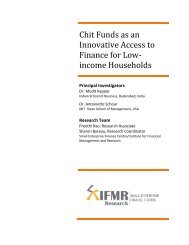Government of India Volume I: Analysis and Recommendations
Government of India Volume I: Analysis and Recommendations
Government of India Volume I: Analysis and Recommendations
Create successful ePaper yourself
Turn your PDF publications into a flip-book with our unique Google optimized e-Paper software.
CHAPTER 3<br />
Structure <strong>of</strong> the regulator<br />
<strong>Government</strong> agencies are required to perform complex functions in eight areas in finance:<br />
consumer protection, micro-prudential regulation, resolution <strong>of</strong> failing financial firms,<br />
capital controls, systemic risk, development, monetary policy <strong>and</strong> debt management.<br />
For these functions to be appropriately performed, well structured <strong>Government</strong> agencies<br />
are required. This is sought to be achieved through a specialised <strong>and</strong> consolidated set <strong>of</strong><br />
provisions on regulatory governance in the draft Code.<br />
The Commission believes that the requirements <strong>of</strong> independence <strong>and</strong> accountability<br />
<strong>of</strong> financial regulators are the same across the financial system <strong>and</strong> hence it recommends<br />
a unified set <strong>of</strong> provisions on financial regulatory governance for all areas <strong>of</strong> finance. The<br />
objective <strong>of</strong> the proposed Code on regulatory governance is to create a series <strong>of</strong> obligations<br />
for the <strong>Government</strong> <strong>and</strong> for regulators. The Code will cover all functions <strong>of</strong> the<br />
regulator <strong>and</strong> lay down the principles <strong>and</strong> st<strong>and</strong>ards <strong>of</strong> behaviour expected from the regulator.<br />
It will also provide for a system <strong>of</strong> monitoring the functions <strong>of</strong> the regulator with a<br />
process to ensure that the regulator is fully transparent <strong>and</strong> they act in compliance with<br />
the best practices <strong>of</strong> public administration. Table 3.1 captures the recommendations <strong>of</strong><br />
the Commission for the creation <strong>of</strong> an appropriate regulatory structure.<br />
The Commission recommends that the structure <strong>of</strong> the regulator be st<strong>and</strong>ardised for<br />
all financial regulators. However, there may be exceptions required in respect <strong>of</strong> certain<br />
specific functions where the general regulatory processes may not apply. These exceptions<br />
to the general process law should be kept to the minimum <strong>and</strong> generally avoided.<br />
3.1. Selection <strong>of</strong> the regulator’s board<br />
Regulators in <strong>India</strong> are statutory entities headed by a board. It is the responsibility <strong>of</strong> the<br />
<strong>Government</strong> to appoint the members on the board <strong>of</strong> the regulator. The Commission<br />
believes that it is necessary to create a statutory system for selecting board members in a<br />
fair <strong>and</strong> transparent manner. It is recommended that the <strong>Government</strong> should be aided in<br />
this process by a pr<strong>of</strong>essional search <strong>and</strong> selection committee. This will help ensure that<br />
the selected members are competent persons with relevant knowledge <strong>and</strong> experience.<br />
The Commission looked at various systems <strong>of</strong> selection committees present under<br />
<strong>India</strong>n laws along with the practice in other common law jurisdictions. Based on this<br />
analysis, it recommends that the government should maintain a panel <strong>of</strong> experts who<br />
will serve as members <strong>of</strong> the selection committee at all times. Their expertise would be<br />
FINANCIAL SECTOR LEGISLATIVE REFORMS COMMISSION 21



